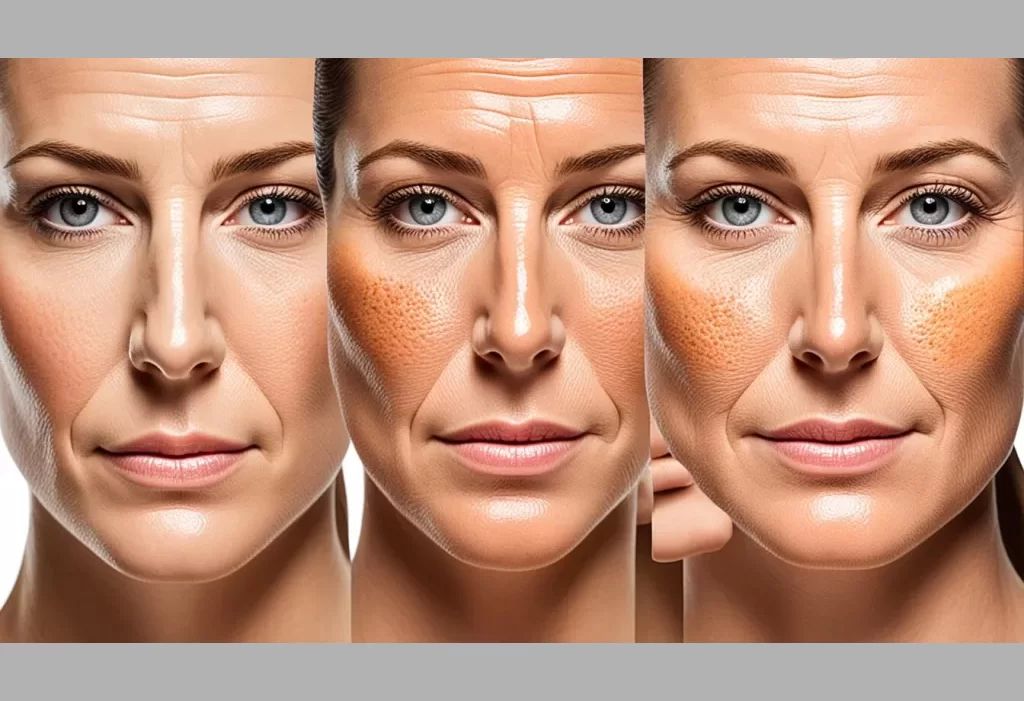Melasma is a common skin issue that shows up as patchy brown or gray spots on the face. Many think it’s only a problem during pregnancy. But, this belief can make people ignore it in those who aren’t pregnant1. The truth is, melasma can happen to anyone, at any age, and for many reasons, not just pregnancy.
Melasma is a tricky condition with many triggers, like too much sun and hormonal shifts2. It’s true that pregnant women often get melasma because of hormonal changes. But, it can also hit people who’ve never been pregnant. Knowing what causes melasma helps us fight and prevent it.
What is Melasma?
Melasma is a skin condition that causes brown or gray patches on the face. Melasma symptoms often show up on the cheeks, forehead, nose, and upper lip. These patches can be symmetrical or irregular in shape. It’s sometimes called the “mask of pregnancy” because hormonal changes during pregnancy can trigger it1.
Symptoms and Appearance
The main melasma appearance is hyperpigmentation on the skin, usually brown or gray. These patches may grow in size and color over time, especially with sun exposure. This can make the discoloration quite noticeable, leading to self-consciousness and concerns about one’s looks1.
Causes and Risk Factors
The exact melasma causes are not clear, but it’s thought to be triggered by hormonal changes and sun exposure. Risk factors include pregnancy, birth control pill use, hormone replacement therapy, thyroid disorders, and a family history of the condition1.
| Melasma Risk Factors | Description |
|---|---|
| Pregnancy | Hormonal changes during pregnancy can trigger melasma. |
| Birth Control Pills | The hormones in birth control pills may contribute to the development of melasma. |
| Hormone Replacement Therapy | Hormone therapy can also lead to the onset of melasma. |
| Thyroid Disorders | Imbalances in thyroid hormones have been linked to melasma. |
| Family History | Individuals with a family member who has melasma are more likely to develop the condition. |
Sun exposure is a big melasma risk factor. UV radiation can make melanin, the pigment causing discoloration, increase. It’s important to protect your skin from the sun to prevent and manage melasma1.
Melasma Isn’t Just a Pregnancy Thing
Melasma is often linked to pregnancy, but it affects people of all ages, genders, and skin types. Melasma not just pregnancy, melasma in men, and melasma in non-pregnant women matter a lot. This condition is more widespread than many think.
Hormonal changes and too much sun are big reasons for melasma. These issues can happen to anyone, pregnant or not3. In fact, up to 33% of non-pregnant women and 10% of men get melasma3. It’s key to spread the word about melasma’s wide impact to help those affected get the right care.
Knowing melasma isn’t just a pregnancy issue helps people understand their skin better. They can then find the right medical help and care. This leads to better skin health and more confidence, no matter their situation.
To wrap it up, melasma is a common skin issue that goes beyond pregnancy. It’s important to know it affects many, including men and non-pregnant women. This knowledge helps people manage their melasma and get healthier, glowing skin.
Sun Exposure and Melasma
Sun exposure is a big reason why melasma gets worse4. The sun’s UV rays make more melanin, causing brown or gray patches on the face4. To stop and manage melasma, it’s key to protect your skin from the sun.
Importance of Sun Protection
For people with melasma, protecting your skin from the sun is a must. Use a broad-spectrum sunscreen with SPF 30 or higher, wear protective clothes, and stay in the shade during the hottest part of the day4. This way, you can lessen the look of melasma and stop it from getting worse4.
Adding sun protection to your daily life is vital for managing melasma. Whether you’re outside or just going for a walk, protecting your skin from the sun’s bad rays is crucial. It can greatly help in managing this common skin issue.
Remember, the sun is a big cause of melasma. By protecting your skin, you can get a clearer, more even skin tone and stop more discoloration4.
Hormonal Changes and Melasma
Hormonal changes are key to melasma, a condition that causes skin to look uneven and discolored5. Things like pregnancy, birth control pills, and hormone therapy can make more melanin. This is the stuff that makes the brown or gray patches on the skin.
When pregnant, the rise in estrogen and progesterone makes more melanin. This leads to the “mask of pregnancy” look5. Birth control or hormone therapy can also cause melasma in both women and men.
But melasma isn’t just a pregnancy thing. Hormonal shifts during menopause or some health issues can cause it too5. Knowing how hormones affect melasma helps in managing and preventing it.
Skin Care Routine for Melasma
Managing melasma means being careful with your daily skin care. Use gentle products that won’t make things worse1. Choose fragrance-free cleansers and moisturizers to keep your skin’s barrier strong and prevent more color changes.
Gentle Cleansers and Moisturizers
Harsh soaps and products with fragrances can dry out your skin, making melasma worse1. Go for gentle, nourishing cleansers and moisturizers made for sensitive skin. These products will soothe and hydrate your skin without upsetting its balance.
Sunscreen Application
Sunscreen is key for managing melasma. Use a broad-spectrum sunscreen with SPF 30 or higher on your face, neck, and hands1. Put it on every two hours, especially when you’re outside. This helps stop melasma from getting darker and prevents new color changes.
Adding these gentle, sun-protective steps to your daily routine can help control melasma. Remember, being consistent is important for your skin’s health and managing this condition.
Treatment Options for Melasma
Managing melasma often requires a mix of treatments. There are many options available, from creams and serums you can buy over-the-counter (OTC) to professional treatments. Working with a dermatologist helps find the best plan for you.
Topical Creams and Serums
For mild to moderate melasma, OTC creams and serums can be helpful. They often have ingredients like hydroquinone, kojic acid, or vitamin C. These can slow down melanin production and lighten the skin1.
For tougher cases, stronger prescription treatments might be needed. These can include retinoids or a mix of hydroquinone, corticosteroids, and other agents.
Professional Treatments
For severe melasma, you might need professional treatments. Options include laser therapy, chemical peels, or microneedling. Lasers, like Q-switched lasers or intense pulsed light (IPL), target and break up melanin in the skin3.
Chemical peels with kojic acid or retinoids can also help. It’s important to talk to a dermatologist to pick the right treatment. They ensure it’s safe and works well1.
Remember, always protect your skin from the sun. Sun exposure can make melasma worse and lessen treatment results.
Melasma Prevention Tips
Melasma is a common skin issue that causes dark patches. It can be hard to manage. But, you can take steps to lower the risk and control it better1.
One key step is to protect your skin from the sun. Use sunscreen with an SPF of 30 or higher. Wear hats and long sleeves, and stay out of the sun during peak hours1.
- Find and avoid things that make melasma worse, like some medicines, hormonal changes, or certain skincare products. Knowing what triggers melasma for you can help stop it from getting worse1.
- If melasma is linked to a health issue like a thyroid problem or hormonal imbalance, managing that can help prevent and control it1.
By doing these things, you can lower your chances of getting melasma or lessen its effects on your skin. Remember, stopping melasma before it starts is the best way to deal with it1.
| Brand | Number of Lights | Wavelengths |
|---|---|---|
| Foreo’s FAQ 202 mask | 600 | 8 wavelengths |
| Therabody’s TheraFace Mask | 648 | 3 wavelengths |
| Omnilux’s Contour Face mask | 132 | – |
| Dr. Dennis Gross Skincare’s DRx SpectraLite FaceWare Pro | 100 red, 62 blue | – |
| Skin LED Light Therapy Mask Face and Neck Kit | 132 | – |
| Red Light Mask by Qure Skincare | – | 5 wavelengths |
| Red Light Face Mask | 62 | – |
| Shani Darden’s Pro LED Light Mask | 238 | – |
| Ora’s LED Light Energy mask | – | red, blue, yellow, green, purple, white |
| Dr. Dennis Gross Skincare’s DRx SpectraLite EyeCare Max Pro Device | 96 red | – |
Also, keep an eye on your skin’s health and get advice from a dermatologist. This can help you manage and prevent melasma1.
By following these tips, you can protect your skin and reduce the effects of melasma1.
Managing Melasma During Pregnancy
Melasma is a common skin issue that can get worse during pregnancy. This happens because of the hormonal changes during this time1. Luckily, there are safe ways to manage melasma and keep it in check.
Safe Treatment Options
For pregnant women with melasma, a gentle skincare routine is key. This includes using broad-spectrum sunscreen every day6. Safe ingredients like Bakuchiol and Glycolic acids can help manage melasma safely6.
Other safe treatments include BBL Photofacial and Diamond Glow Facial. These should be done under a dermatologist’s care6.
It’s important for pregnant women with melasma to talk to their healthcare providers. Together, they can create a safe plan. This plan might include skincare products, sun protection, and professional treatments1. By being proactive, pregnant women can manage their melasma and keep their skin healthy and glowing.
Lifestyle Changes for Melasma
Changing your lifestyle can help manage melasma, along with treatments and procedures1. Stress management like meditation or yoga can lessen the effects of hormonal changes that cause melasma1. Eating well and fixing hormonal issues or thyroid problems with diet or supplements can also help1.
Stress makes melasma worse by causing hormonal and inflammation issues1. Adding stress-reducing activities daily can lessen melasma’s appearance1. Eating foods full of antioxidants and vitamins supports skin health and may reduce melasma’s effects1.
Combining these lifestyle changes with good skin care and sun protection can improve melasma control and skin health1. This approach tackles both outside and inside factors that affect melasma, offering a full solution for this common skin issue1.
When to See a Dermatologist
If you’re worried about melasma or if your skin color keeps changing, see a dermatologist1. They can diagnose melasma and check for other skin issues. They’ll also suggest the best treatment options1.
For some, professional treatments like laser therapy or chemical peels might be needed to fix melasma1. It’s key to get help from a dermatologist to manage this skin issue well and get the look you want.
- A dermatologist can accurately diagnose melasma and rule out any underlying conditions.
- Professional treatments, like laser therapy or chemical peels, may be recommended to improve the appearance of melasma.
- Consulting a dermatologist is essential for effectively managing melasma and achieving the desired results.
| Product | Number of LED Lights | Light Wavelengths | Price |
|---|---|---|---|
| FAQ 202 | 600 | 8 | $799.00 |
| TheraFace Mask | 648 | 3 | $599.00 |
| Contour Face | 132 | 2 | $395.00 |
| DRx SpectraLite FaceWare Pro | 162 | 2 | $455.00 |
| Skin LED Light Therapy Mask | 132 | Not specified | $647.00 |
| Red Light Mask | 62 | 1 | $349.00 |
| Pro LED Light Mask | 238 | Not specified | $1900.00 |
| LED Light Energy Mask | Not specified | 6 | $75.00 |
3 This table compares different LED light therapy devices. It shows the number of LED lights, light wavelengths, and prices3.
5 Red spots can come from heat rash, cherry angiomas, contact dermatitis, or ringworm5. Always get expert medical advice to find and treat the real cause of these skin changes.
Conclusion
Melasma is a common skin issue that can happen to anyone, not just pregnant people1. It’s often linked to hormonal shifts, but the sun also plays a big role in making it worse. To manage it, it’s key to have a good skincare routine, protect your skin from the sun, and try both over-the-counter and professional treatments1. Making lifestyle changes like handling stress and keeping hormones balanced can also help.
Learning about melasma overview, its causes, and how to prevent and treat it lets people take action for better skin1. Using strong treatments and LED light therapy devices3 can help people feel confident again and keep their skin looking healthy.
In short, the key takeaways are that melasma is widespread, not just tied to pregnancy, and it’s caused by sun exposure and hormonal changes. A mix of skincare, sun protection, and professional help can manage it well. By tackling melasma early, people can reach their skin goals and boost their health.
FAQ
What is melasma?
Melasma is a common skin condition. It causes patchy brown or gray discoloration on the face. Hormonal changes and sun exposure trigger it.
What causes melasma?
The exact cause of melasma is not fully known. But hormonal changes and sun exposure are key factors. Pregnancy, birth control pills, hormone replacement therapy, thyroid disorders, and family history increase the risk.
Can melasma affect non-pregnant individuals?
Yes, melasma can happen to anyone, not just pregnant people. It can affect both men and women. Hormonal changes or too much sun can trigger it.
How important is sun protection for managing melasma?
Sun exposure is a big trigger for melasma. UV rays make melanin levels go up, causing the brown or gray patches. Using broad-spectrum sunscreen is key to prevent and manage melasma.
How do hormonal changes contribute to melasma?
Hormonal shifts play a big part in melasma. Things like pregnancy, birth control pills, and hormone therapy can make melanin levels rise. This leads to the discoloration of melasma.
What should I consider in my skin care routine for melasma?
For melasma, a good skin care routine is crucial. Use gentle cleansers and moisturizers. Always apply sunscreen on your face, neck, and hands correctly and often.
What treatment options are available for melasma?
There are many ways to treat melasma. You can use OTC or prescription creams and serums. Or try professional treatments like laser therapy, chemical peels, and microneedling. A dermatologist can help pick the best option for you.
How can I prevent melasma?
Preventing melasma isn’t guaranteed, but you can lower the risk. Use proper sun protection, avoid triggers, and manage hormonal issues. This can help control the condition.
How can melasma be managed during pregnancy?
During pregnancy, work with your healthcare provider to manage melasma safely. Use gentle skincare products and sunscreen. Consider safe professional treatments like chemical peels or microneedling with a dermatologist’s advice.
How can lifestyle changes help manage melasma?
Changing your lifestyle can help with melasma. Try stress management, eat well, and balance your hormones. Combine this with good skin care and sun protection for better results.
When should I see a dermatologist for melasma?
If melasma worries you or gets worse, see a dermatologist. They can diagnose it, check for other conditions, and suggest the best treatments.
Source Links
- https://www.verywellhealth.com/rash-on-palms-8684299 – Got a Rash on Your Palms? Here’s What You Need to Know
- https://www.babycenter.com/pregnancy/week-by-week/12-weeks-pregnant – 12 Weeks Pregnant: Symptoms, Belly & More
- https://www.aol.com/10-best-led-face-masks-184700867.html – The 10 Best LED Face Masks to Address Wrinkles, Acne, and More
- https://www.verywellhealth.com/rashes-with-blisters-1069592 – Itchy Bumps Filled With Clear Liquid: What’s Causing Them?
- https://www.verywellhealth.com/red-spots-on-skin-5112642 – Red Spots on the Skin: Causes, Diagnosis, and Treatments
- https://ca.style.yahoo.com/best-pregnancy-safe-skincare-treatments-002408140.html – The Best Pregnancy-Safe Skincare Treatments, According to Experts















